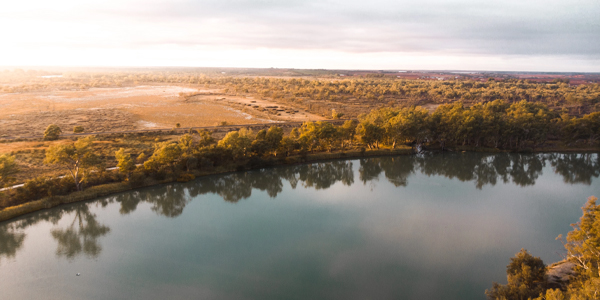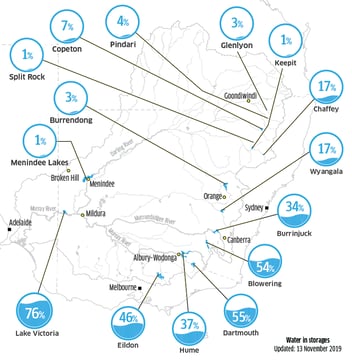Declining streamflow in the Northern Murray-Darling Basin

While climate change is already having a very big impact on Australia, the multi-billion-dollar question for the nation’s prime food bowl, the Murray Darling Basin, is how much is climate change responsible for declining stream flows and how much is it due to irrigation? Discerning which of the two variables is at play (and by how much) is not an easy task.
Here, an Australian National University team discuss how they took on this big challenge. They found that increased water diversions are having as big an impact on declining stream flows as is climate change in the northern Murray-Darling Basin. The takeaway message is that Australia must reduce its sustainable diversion limits to secure a just and prosperous future in the northern Murray-Darling Basin.
In our study recently published in the Journal of Hydrology: Regional Studies, we analyzed the changes in stream flows in all the major catchments of the northern Murray-Darling Basin, Australia, from 1981 to 2020 (Chu et al, 2025). We found that increased water diversions are having as big an impact on declining stream flows as is climate change.
As Australia prepares for the next Basin Plan, our findings highlight the critical need to reduce sustainable diversion limits in the northern Murray-Darling Basin. Without this change, the next Basin Plan will not deliver the sustainable level of extractions that Australia needs and which our federal Water Act 2007 mandates.
The problem of water diversions
Globally, increased water diversions are expected to continue in all climate projections. This will exacerbate declines in streamflow in many arid and semi-arid regions, including in the northern Murray-Darling Basin (Basin), Australia. Some claim that the principal cause (and even the only cause) of declining stream flows is climate change.
But this ignores the fact that hydrological droughts are caused by increased water diversions, that is, too much water being diverted for use and consumption. Excessive water diversions in the northern Basin have contributed to mass fish kills, degraded ecosystem health, damaged ecological functions and caused poor water quality (e.g. blackwater events, high salinity, nutrient pollution).
The 2012 Basin Plan focus was on establishing an environmentally sustainable level of take (diversions) of water from the basin river systems. This was to be achieved, primarily, by decreased irrigation water diversions.
The most recent and comprehensive study of the state of the Basin shows that the 2012 Basin Plan has failed to deliver on its promises and what is required under the federal Water Act 2007: “…to protect, restore and provide for the ecological values and ecosystem services of the Murray‑Darling Basin.”
While climate change is already having a very big impact on Australia (eg, rising temperatures, more variable rainfall, sea-level rise), the multi-billion-dollar question is how much is climate change responsible for declining stream flows and how much is it due to increased irrigation water diversions in the Basin?
Building on an earlier study, we asked: What has happened to stream flow in all major catchments in the northern Basin? What proportion of any decline in stream flow is due to long-term meteorological trends (eg, higher temperatures, lower rainfall)? And what proportion of any decline in stream flow is due to increasing water diversions?
First, we collected a great deal of data on temperatures, rainfall, evaporation and stream flows across the northern Basin over the period 1981-2020. Next, we estimated what proportion of any decline in stream flow was due to meteorological trends (eg, change in annual rainfall and evaporation) consistent with climate change, and what proportion remains ‘unexplained’ by these meteorological trends.
Determining the unexplained portion
Our findings are summarized in Figure 1 for the seven major catchments in the northern Basin. In the figure, each catchment has a different colour with its location colour-coded in the top lefthand map.
Our estimated average annual streamflow decline due to long-term meteorological effects is shown by a bell-shaped distribution curve for each catchment. The actual, measured decline in stream flow over the 2001-2020 period, compared to the 1981-2000 period, is given by a vertical black line.
In the Paroo and Warrego catchments, where irrigation water diversions are virtually nil, recorded streamflow declines are explained by meteorological trends alone. That is, the vertical black line representing the observed decline in streamflow lies within the estimated frequency distribution of what can be attributed to meteorological change.
In the Warrego catchment, where irrigation is very limited, the actual decline in streamflow is a little greater than the estimated mean of the stream decline explained by meteorological trends. Nevertheless, the stream flow decline on the Warrego River is within our estimated frequency distribution and the 95% confidence interval of the expected streamflow decline.
For the other five catchments (ie, not the Paroo or Warrego catchments) that have major irrigation water diversions, meteorological-driven declines in average annual streamflow alone do not explain the reported declines in streamflow. In all cases, the observed decline in stream flow lies outside the 95% confidence interval of the expected stream flow decline attributable to long-term meteorological trends.
The actual decline in stream flow in these five irrigation catchments (Condamine/Balonne, Border Rivers, Gwydir, Namoi/Peel, and Macquarie/Castlereagh/Bogan) was about twice the expected decline from meteorological trends alone.
Further, for these five catchments (but not the Paroo and Warrego), the hypothesis that observed annual streamflow decline is solely attributable to meteorological trends is robustly rejected. That is, something else, other than climate change, is reducing stream flows in northern Basin catchments where there are already substantial irrigation water diversions.
The most likely explanation
The most likely explanation for reduced streamflow, over and above expected impacts of climate change, are reported increases in irrigation water diversions and increased floodplain harvesting.
Together, they have already contributed to reduced baseflows downstream and connectivity, lowered ecosystem resilience and generated adverse environmental, social, and cultural outcomes.
A partial recovery in streamflow (compared to long-term historic trends) could be achieved by a sufficiently large reduction in irrigation water diversions in the next Basin Plan.
To quantify the likely costs of a voluntary buy back of water entitlements to increase stream flows, we estimated the impact of two possible water reallocation scenarios in the northern Basin: (i) return streamflow to its mean value over the 1980-2000 period; and (ii) ensure no change in the mean ratio of irrigation water withdrawals to streamflow between 2006-2020 and 1980-2000. Under scenarios (i) and (ii), the gross value of irrigated agriculture in the five catchments would be reduced by 9%-14%, and 19%-29%, respectively.
The consequences
Without additional stream flow in the northern Basin, critically important environmental water requirements will not be achieved. Lack of water in the rivers will see fish kills continue. This will perpetuate the poor riverine and floodplain health across the northern Basin and the on-going degradation of our Living Rivers.
The status quo also contravenes the law of the land (Water Act 2007) and imposes huge costs (social, cultural and economic) on downstream communities (including our non-human cousins) who depend on rivers that flow.
We can, and must, do much better for the next Basin Plan.
This article was originally published by Global Water Forum.


